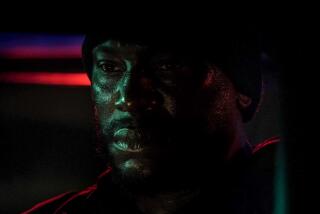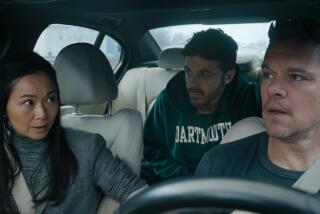Woody Harrelson goes behind the badge
Woody Harrelson wants the windows down. “Do you mind if we go old style on this? I don’t like air conditioning.” The journalist at the wheel of the Honda Accord jabs a button and the famous passenger gets a face full of Sunset Strip. Harrelson is used to breathing in paradise — he lives in Maui most of the time — but even West Hollywood tastes sweet when you feel like you’re smothering. “Yeah,” the 50-year-old star said, “that’s better already.”
It’s understandable if Harrelson needs to remind himself to breath deeply right about now. A few months ago he was viewed as a likely Oscar and Golden Globe contender for playing an unhinged LAPD cop in the new drama “Rampart,” but any chances he had for a nomination got lost in the mail. The DVD screeners of the film sent to awards voters had been compressed and replicated incorrectly and were, essentially, unwatchable.
“It’s just frustrating,” Harrelson said. “They send out the screeners and they’re defective; 3,500 defective screeners. They couldn’t just re-send, either. There’s a policy with the academy that, unless someone asks — like, specifically writes a letter to ask — it doesn’t happen. Look, if I’m watching a screener and one them is defective I just toss it aside, there’s plenty more to watch. It’s a bit of a bummer.”
“Rampart” opens in commercial release this weekend (it had a one-week run in November in Los Angeles and New York to qualify for the trophy season) as something of a cinematic hot mess. Some movie critics are conflicted about the film’s accomplishments but almost all admired director Oren Moverman’s risks and the work of Harrelson. Owen Gleiberman of Entertainment Weekly, for instance, praised the “intricate demonic force” that Harrelson invested in bad-cop Dave Brown but also acknowledged that the movie “won’t be for everyone.”
Early on, Harrelson wasn’t completely sure the movie was him, either. As a “happy hippie from Hawaii,” as he describes himself, wearing the uniform and scowl of a racist renegade cop was a challenge, but he very much wanted to reunite with director Moverman and costar Ben Foster, the team that worked on “The Messenger,” the 2009 film which did net Harrelson an Oscar nomination.
Harrelson dropped 30 pounds, spent two weeks on ride-alongs with cops and former cops and hit the gun range, all to take aim at something authentic in his portrayal.
“The first time I put on the uniform it just didn’t feel real to me, it felt like Halloween, just a costume,” Harrelson said. “But Oren saw me and was like, ‘Yes!’ He could see it, but I just couldn’t at that point. That was a month before shooting. Eventually I started to feel I was in the spin of this guy. It’s amazing how things can shift. The thing is I have to make myself believe it or nobody else will.”
Harrelson has played characters with deranged charisma — his work in “Natural Born Killers,” “Zombieland” and “No Country for Old Men” spring to mind — but none of them affected him the way this role did, he said during a recent visit to Los Angeles.
Friends picked up on “this sort of perpetual paranoia and anger at the world” that was bouncing around inside the actor’s cranium during the seven-week shoot and they were relieved after he took off the uniform. Harrelson said he found that dark energy in the script and in his investigations of the hard-edged lawman mentality.
“Aside from all the other research — reading every book or watching documentaries, movies, anything to do with cops and just trying to absorb as much as I could about cops and also specifically about the LAPD and the history of it — I felt like the thing that helped the most was riding along with these guys,” Harrelson said. “And going from being a little nervous and shocked at what I was seeing to, you know, really respecting these guys and feeling the humanity in these guys and feeling like, ‘I could be a cop.’”
Harrelson said that he gained fresh insight into their culture and level of commitment — things that helped him understand what the young version of Dave Brown might have been like, the uncorrupted one that joined the force with intention to do good.
Harrelson’s politics and liberal stand toward marijuana don’t make him the kind of actor that cops ask for autographs so there were uneasy looks on both sides when the actor was introduced to the veteran officers who took him on patrol to research his role. Chic Daniel, who retired from the LAPD after 26 years on the job, was one of the veterans who took Harrelson on patrol of the city’s meaner streets.
“You spend time with someone and you find that common ground and you share a bit of yourself and that’s what happened with Woody,” Daniel said. “We hope to give actors information so when they do these things on the screen, there’s some kind of accuracy there. I enjoyed spending time with him and he did a great job in this. There were a lot of other scenes they had that didn’t make it into the movie that were more on-the-street stuff. When I watched it, I did enjoy it but I thought it was going to be something different.”
Indeed, during the shoot, Harrelson was not the only part of the project undergoing a transformation.
The original script by crime author James Ellroy was, as the title of the film suggests, rooted in the events of Rampart scandal that infamously rocked the LAPD in the 1990s and still conjures up images of corrupt cops planting evidence, dealing drugs and acting like gangsters with badges.
Moverman, who got an Oscar nomination for “The Messenger” screenplay, took the script to a different place; the Rampart scandal is the blurred backdrop of the final version of the movie and the emphasis is on the life inside the home and head of Brown. He is a terrible policeman but, in his own way, he is a devoted father and he loses his grip when he fears for his family, even if it is a nontraditional tribe.
“His kids mean the world to him and that makes you say, ‘Well, he can’t be all bad,’” Harrelson said. “I’m a father and that’s where I looked for that connection to him, the thing where I could see myself. You start there and then go looking for the rest.”
Those scenes in the home were the most fascinating to Moverman and they tilted his edit of the final film. Harrelson was initially shocked when he saw that Moverman had jettisoned scenes that were closer to, say, “Training Day,” in the portrayal of on-the-street action.
The film is a search for the emotional truth of this character, according to Moverman, and that truth was in the scenes with his two ex-wives, portrayed by Anne Heche and Cynthia Nixon, who are also sisters and live under the same roof.
“The movie that felt interesting and different and maybe special was the movie about the interior life, not the one that takes usual path,” Moverman said. “The scenes with women and the scenes with his daughters, those [were the moments with traction]. Woody was surprised when he saw that version but I think we did the right thing.”
Harrelson did eventually come to agree that Moverman had a bolder and better movie that he should embrace, even if wasn’t the project he expected. “You have to admit when you’re wrong,” Harrelson said. “And that’s what I told Oren. I put my heart into this one. It went to some places I didn’t expect but I’m really, really proud of it.”
More to Read
The biggest entertainment stories
Get our big stories about Hollywood, film, television, music, arts, culture and more right in your inbox as soon as they publish.
You may occasionally receive promotional content from the Los Angeles Times.










